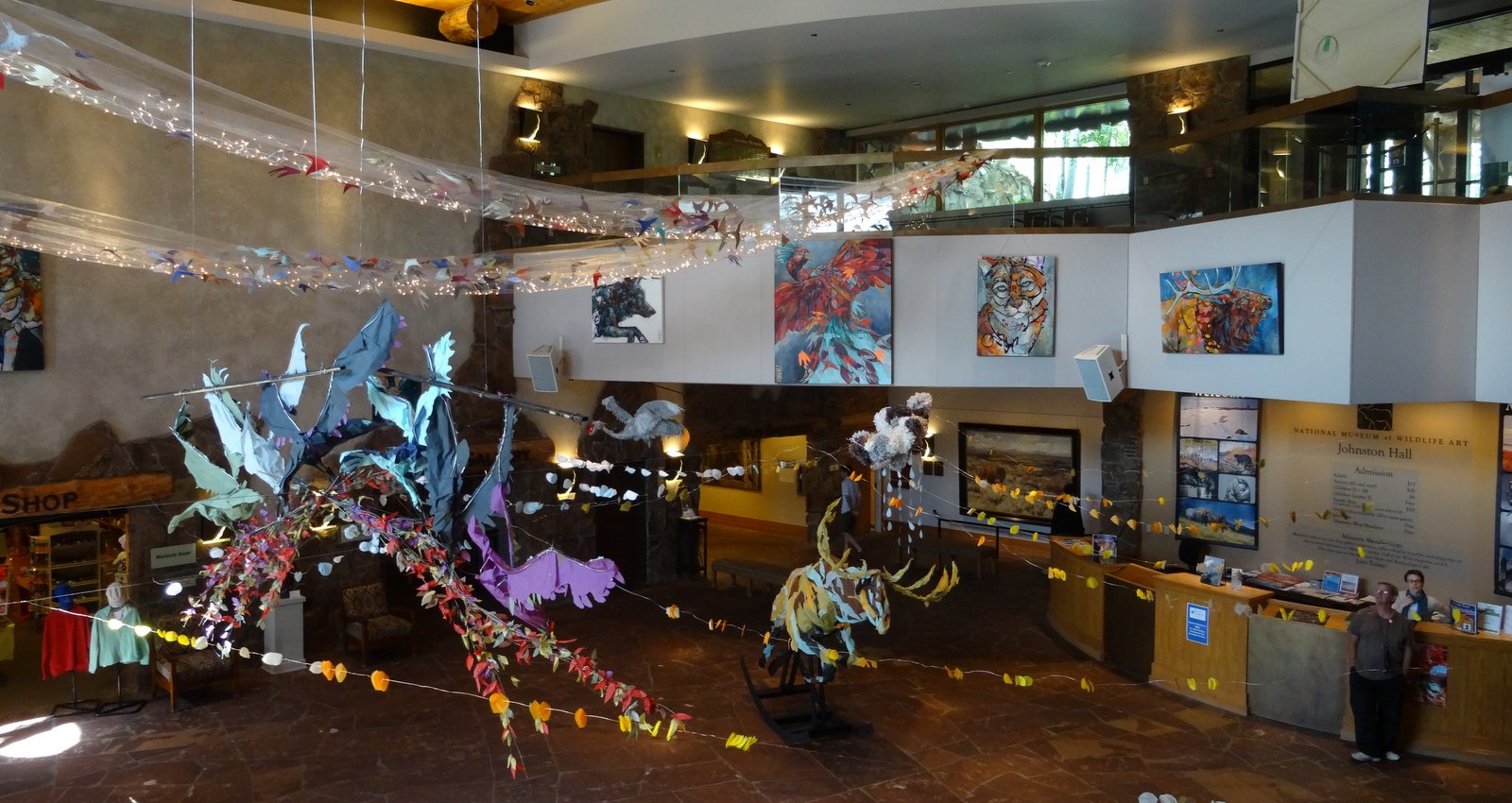I had the alarm set for 5:00 a.m. and the plan was to head directly to Schwabacher's Landing. A short hike led us to an often photographed spot along the Snake River. Being so popular meant we would have company. There was no hope of seeing moose when I could hear the earlier photographers talking and laughing from 50 yards away. Oh well, at least the view did not disappoint!
It was very cold (low 40s) in Grand Teton National Park.
Still pretty dark - the little beaver pond sleeps.
The prime spot, with the better framing, was occupied. Next time, 30 minutes earlier and we may have a chance.
The peaks were ablaze with morning light that had yet reached the valley floor.
The morning glow on the Tetons was fading, but the trees were coming alive.
The art of Amy Ringholz dominated the Johnston Hall and gave it a party atmosphere.

For David to want to pay cold hard cash to visit an art museum twice, speaks volumes to this museum's appeal. I think this painting by Robert Bateman is largely the reason. This time we watched a video (twice) showing the process Bateman used to achieve this masterpiece.

NOTE: Hudson River School was not a school at all. It was coined in the 1870s and intended as an insult, but the moniker stuck.

Breathtaking (and large, about 30" across and deep and 24" tall) carving by Leo E. Osborne, Brothers of the Wood, (Maple Burl Wood).
Mr. Osborne has cast this in bronze and it can be yours for $12,000.

William H. Dunton, Black Tail Deer in Aspens, 1925 (oil on canvas)
This painting has such a modern sensibility, I was surprised by the year it was painted.

Georgia O'Keeffe, Antelope, 1954 (oil on canvas)

Bart Walter, Wapiti Trail, modeled 2005, cast 2007 (bronze)
Little Emerson taught us that "wapiti" is a Cree word meaning "white butt".

Following our photography outing, we returned to the coach for breakfast. Sam was happy to see us. He was wondering "what happened to my morning walk?" We cleaned up and headed to the National Museum of Wildlife Art in Jackson Hole. This museum made quite an impression on us when we visited last year and it was a must see again this visit. Arriving at 10:00, our plan was to spend the remainder of the day in the museum, including lunch in their Rising Sage Cafe.

If this looks familiar, it is because a little over a year ago David was similarly mesmerized by "Chief".

Another hauntingly beautiful painting by Robert Bateman, Lone Raven, 2002 (acrylic on linen).
Albert Bierstadt, Wind River Range, 1859 (oil on board)
This is by far not the best example of Albert Bierstadt's work, but being a Hudson River School groupie, I was thrilled to view it.NOTE: Hudson River School was not a school at all. It was coined in the 1870s and intended as an insult, but the moniker stuck.

I love the humor in this painting by Philip R. Goodwin, The Surprise (aka Reel Adventure), 1925 (oil on canvasboard). It's a familiar scene in these parts!
Mr. Osborne has cast this in bronze and it can be yours for $12,000.

N. C. Wyeth, How Many Millions, One Can Only Guess, 1905, (oil on canvas)
This painting has such a modern sensibility, I was surprised by the year it was painted.

Georgia O'Keeffe, Antelope, 1954 (oil on canvas)

I love this painting by Sir Edwin H Landseer, The Deer Pass, 1852 (oil on canvas). We witnessed the same "You look'n at me" expression from the big boys we came upon in the Hoh Rain Forest.
Carl Rungius, Survival of the Fittest, 1901-1904 (oil on canvas).
When we visited this museum last year, we fell in love with the works of Carl Rungius (National Museum of Wildlife Art has the largest public collection). The museum effectively shows how his style's progressed over the years.
Carl Rungius, Pronghorned Antelope Study, 1910 (oil on canvas).
Carl Rungius, Morning Mist, 1930 (oil on canvas).
Carl Rungius, Dall Sheep, 1930 (oil on canvas).
Carl Rungius, Old Man of the Mountains, 1930 (oil on canvas).
Carl Rungius, Herd of Elk, 1959 (oil on canvas)
This was painted the same year that Carl Rungius died at age 90. It is unsigned and it appears to be unfinished.
Nick Brandt, Cheetah and Cubs, Maasai Mara, 2003 (platinum print).
A striking collection of photographs by Nick Brandt, taken without the aid of telephoto lenses.
Outside the museum, there was an extensive collection of bronze sculptures to explore, but after five hours inside and what appeared to be a pretty significant storm nearing we chose to head back to the coach. We will be able to wander around the sculptures and study the museum's architecture another day.
Little Emerson taught us that "wapiti" is a Cree word meaning "white butt".

It looked like a storm was a-comin'. Time to go home and comfort Sam.




















No comments:
Post a Comment